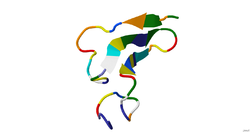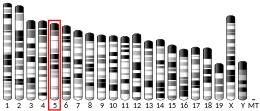에피레귤린
Epiregulin에피레굴린(EPR)은 인간의 EREG [5][6]유전자에 의해 암호화되는 단백질이다.
구조.
에피레굴린은 46개의 아미노산 잔기로 구성되어 있다.그것의 2차 구조는 가닥에 [7]β-시트의 약 30%를 포함한다.잔류물 중 일부는 수소 [7]결합에 의해 루프를 형성하고 회전합니다.에피레귤린에서 β-시트의 비율은 도메인과 이들이 점유하는 2차 구조에 따라 달라진다.에피레굴린의 고분자 분자는 폴리펩타이드([7]L)와 폴리머 타입의 공식 중량이 5280.1 g/mol이다.
대부분의 단백질에서 구조적 모티브는 모든 β 모티브에서 전형적인 연결을 가진다.즉, 폴리펩타이드 사슬이 교차 연결을 하지 않으며, 이러한 유형의 연결은 관찰되지 않았습니다.에피레굴린은 모든 β 모티브에서 전형적인 연결을 차지하는 단백질 중 하나이다.또한 에피레귤린의 구조는 β 모티브로 사슬을 형성하므로 β 헤어핀 구조 모티브도 형성한다.β 헤어핀은 인접한 2개의 반평행 β 가닥이 β턴에 의해 연결된 경우이다.
기능.
에피레굴린은 표피성장인자군의 구성원이다.에피레굴린은 표피 성장인자 수용체(EGFR)의 배위자뿐만 아니라 티로신-키나아제 [6]수용체의 ERBB(v-erb-b2 oncogen homolog) 계열의 대부분 구성원의 배위자로 기능할 수 있다.C 말단 에피레굴린의 2차 구조는 수소 결합이 없기 때문에 다른 표피 성장 인자 계열 리간드와 다르다.C 말단에서의 구조적 차이는 ERBB [7]수용체에 대한 에피레굴린의 감소된 결합 친화력에 대한 설명을 제공할 수 있다.
레퍼런스
- ^ a b c GRCh38: 앙상블 릴리즈 89: ENSG00000124882 - 앙상블, 2017년 5월
- ^ a b c GRCm38: 앙상블 릴리즈 89: ENSMUSG000029377 - 앙상블, 2017년 5월
- ^ "Human PubMed Reference:". National Center for Biotechnology Information, U.S. National Library of Medicine.
- ^ "Mouse PubMed Reference:". National Center for Biotechnology Information, U.S. National Library of Medicine.
- ^ Toyoda H, Komurasaki T, Uchida D, Morimoto S (August 1997). "Distribution of mRNA for human epiregulin, a differentially expressed member of the epidermal growth factor family". Biochem. J. 326 (1): 69–75. doi:10.1042/bj3260069. PMC 1218638. PMID 9337852.
- ^ a b "Entrez Gene: epiregulin".
- ^ a b c d Sato K, Nakamura T, Mizuguchi M, Miura K, Tada M, Aizawa T, Gomi T, Miyamoto K, Kawano K (October 2003). "Solution structure of epiregulin and the effect of its C-terminal domain for receptor binding affinity". FEBS Lett. 553 (3): 232–8. doi:10.1016/s0014-5793(03)01005-6. PMID 14572630. S2CID 24761378.
추가 정보
- Yamamoto T, Akisue T, Marui T, et al. (2004). "Expression of betacellulin, heparin-binding epidermal growth factor and epiregulin in human malignant fibrous histiocytoma". Anticancer Res. 24 (3b): 2007–10. PMID 15274392.
- Li S, Takeuchi F, Wang JA, et al. (2008). "Mesenchymal-epithelial interactions involving epiregulin in tuberous sclerosis complex hamartomas". Proc. Natl. Acad. Sci. U.S.A. 105 (9): 3539–44. Bibcode:2008PNAS..105.3539L. doi:10.1073/pnas.0712397105. PMC 2265180. PMID 18292222.
- Cho MC, Choi HS, Lee S, et al. (2008). "Epiregulin expression by Ets-1 and ERK signaling pathway in Ki-ras-transformed cells". Biochem. Biophys. Res. Commun. 377 (3): 832–7. doi:10.1016/j.bbrc.2008.10.053. PMID 18948081.
- Lindvall C, Hou M, Komurasaki T, et al. (2003). "Molecular characterization of human telomerase reverse transcriptase-immortalized human fibroblasts by gene expression profiling: activation of the epiregulin gene". Cancer Res. 63 (8): 1743–7. PMID 12702554.
- Morita S, Shirakata Y, Shiraishi A, et al. (2007). "Human corneal epithelial cell proliferation by epiregulin and its cross-induction by other EGF family members". Mol. Vis. 13: 2119–28. PMID 18079685.
- Freimann S, Ben-Ami I, Dantes A, et al. (2004). "EGF-like factor epiregulin and amphiregulin expression is regulated by gonadotropins/cAMP in human ovarian follicular cells". Biochem. Biophys. Res. Commun. 324 (2): 829–34. doi:10.1016/j.bbrc.2004.09.129. PMID 15474502.
- Ben-Ami I, Armon L, Freimann S, et al. (2009). "EGF-like growth factors as LH mediators in the human corpus luteum". Hum. Reprod. 24 (1): 176–84. doi:10.1093/humrep/den359. PMID 18835871.
- Shigeishi H, Higashikawa K, Hiraoka M, et al. (2008). "Expression of epiregulin, a novel epidermal growth factor ligand associated with prognosis in human oral squamous cell carcinomas". Oncol. Rep. 19 (6): 1557–64. doi:10.3892/or.19.6.1557. PMID 18497965.
- Taylor DS, Cheng X, Pawlowski JE, et al. (1999). "Epiregulin is a potent vascular smooth muscle cell-derived mitogen induced by angiotensin II, endothelin-1, and thrombin". Proc. Natl. Acad. Sci. U.S.A. 96 (4): 1633–8. Bibcode:1999PNAS...96.1633T. doi:10.1073/pnas.96.4.1633. PMC 15542. PMID 9990076.
- Zhang J, Iwanaga K, Choi KC, et al. (2008). "Intratumoral epiregulin is a marker of advanced disease in non-small cell lung cancer patients and confers invasive properties on EGFR-mutant cells". Cancer Prev Res (Phila). 1 (3): 201–7. doi:10.1158/1940-6207.CAPR-08-0014. PMC 3375599. PMID 19138957.
- Draper BK, Komurasaki T, Davidson MK, Nanney LB (2003). "Epiregulin is more potent than EGF or TGFalpha in promoting in vitro wound closure due to enhanced ERK/MAPK activation". J. Cell. Biochem. 89 (6): 1126–37. doi:10.1002/jcb.10584. PMID 12898511. S2CID 24643892.
- Révillion F, Lhotellier V, Hornez L, Bonneterre J, Peyrat JP (January 2008). "ErbB/HER ligands in human breast cancer, and relationships with their receptors, the bio-pathological features and prognosis". Ann. Oncol. 19 (1): 73–80. doi:10.1093/annonc/mdm431. PMID 17962208.
- Ben-Ami I, Freimann S, Armon L, et al. (2006). "PGE2 up-regulates EGF-like growth factor biosynthesis in human granulosa cells: new insights into the coordination between PGE2 and LH in ovulation". Mol. Hum. Reprod. 12 (10): 593–9. doi:10.1093/molehr/gal068. PMID 16888076.
- Takahashi M, Hayashi K, Yoshida K, et al. (2003). "Epiregulin as a major autocrine/paracrine factor released from ERK- and p38MAPK-activated vascular smooth muscle cells". Circulation. 108 (20): 2524–9. doi:10.1161/01.CIR.0000096482.02567.8C. PMID 14581411.
- Lasky-Su J, Neale BM, Franke B, et al. (2008). "Genome-wide association scan of quantitative traits for attention deficit hyperactivity disorder identifies novel associations and confirms candidate gene associations". Am. J. Med. Genet. B Neuropsychiatr. Genet. 147B (8): 1345–54. doi:10.1002/ajmg.b.30867. PMID 18821565. S2CID 9493672.
- Gupta GP, Nguyen DX, Chiang AC, et al. (2007). "Mediators of vascular remodelling co-opted for sequential steps in lung metastasis". Nature. 446 (7137): 765–70. Bibcode:2007Natur.446..765G. doi:10.1038/nature05760. PMID 17429393. S2CID 4420038.
- Shirakata Y, Komurasaki T, Toyoda H, et al. (2000). "Epiregulin, a novel member of the epidermal growth factor family, is an autocrine growth factor in normal human keratinocytes". J. Biol. Chem. 275 (8): 5748–53. doi:10.1074/jbc.275.8.5748. PMID 10681561.
이 기사에는 미국 국립 의학 도서관(미국 국립 의학 도서관)의 공공 도메인 텍스트가 포함되어 있습니다.









